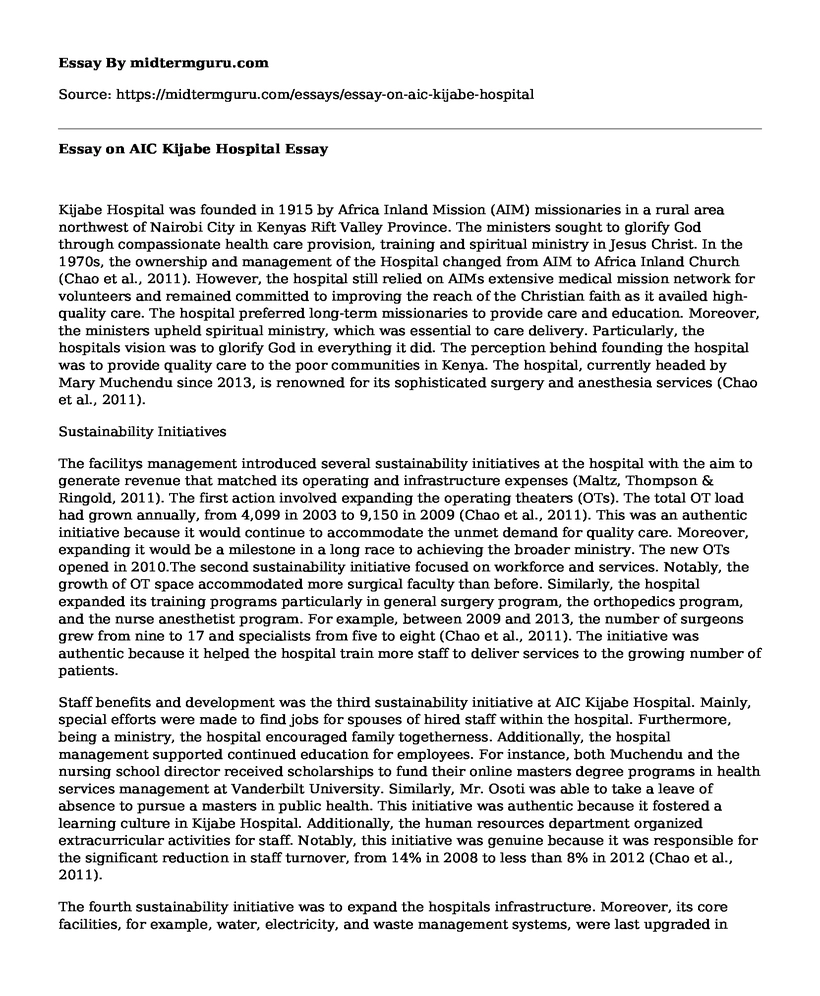Kijabe Hospital was founded in 1915 by Africa Inland Mission (AIM) missionaries in a rural area northwest of Nairobi City in Kenyas Rift Valley Province. The ministers sought to glorify God through compassionate health care provision, training and spiritual ministry in Jesus Christ. In the 1970s, the ownership and management of the Hospital changed from AIM to Africa Inland Church (Chao et al., 2011). However, the hospital still relied on AIMs extensive medical mission network for volunteers and remained committed to improving the reach of the Christian faith as it availed high-quality care. The hospital preferred long-term missionaries to provide care and education. Moreover, the ministers upheld spiritual ministry, which was essential to care delivery. Particularly, the hospitals vision was to glorify God in everything it did. The perception behind founding the hospital was to provide quality care to the poor communities in Kenya. The hospital, currently headed by Mary Muchendu since 2013, is renowned for its sophisticated surgery and anesthesia services (Chao et al., 2011).
Sustainability Initiatives
The facilitys management introduced several sustainability initiatives at the hospital with the aim to generate revenue that matched its operating and infrastructure expenses (Maltz, Thompson & Ringold, 2011). The first action involved expanding the operating theaters (OTs). The total OT load had grown annually, from 4,099 in 2003 to 9,150 in 2009 (Chao et al., 2011). This was an authentic initiative because it would continue to accommodate the unmet demand for quality care. Moreover, expanding it would be a milestone in a long race to achieving the broader ministry. The new OTs opened in 2010.The second sustainability initiative focused on workforce and services. Notably, the growth of OT space accommodated more surgical faculty than before. Similarly, the hospital expanded its training programs particularly in general surgery program, the orthopedics program, and the nurse anesthetist program. For example, between 2009 and 2013, the number of surgeons grew from nine to 17 and specialists from five to eight (Chao et al., 2011). The initiative was authentic because it helped the hospital train more staff to deliver services to the growing number of patients.
Staff benefits and development was the third sustainability initiative at AIC Kijabe Hospital. Mainly, special efforts were made to find jobs for spouses of hired staff within the hospital. Furthermore, being a ministry, the hospital encouraged family togetherness. Additionally, the hospital management supported continued education for employees. For instance, both Muchendu and the nursing school director received scholarships to fund their online masters degree programs in health services management at Vanderbilt University. Similarly, Mr. Osoti was able to take a leave of absence to pursue a masters in public health. This initiative was authentic because it fostered a learning culture in Kijabe Hospital. Additionally, the human resources department organized extracurricular activities for staff. Notably, this initiative was genuine because it was responsible for the significant reduction in staff turnover, from 14% in 2008 to less than 8% in 2012 (Chao et al., 2011).
The fourth sustainability initiative was to expand the hospitals infrastructure. Moreover, its core facilities, for example, water, electricity, and waste management systems, were last upgraded in 1978. The strain on utilities was starting to show evidenced by sewage breakdown ponds that overflowed to the neighboring communities, sporadic hospital-wide blackouts, water shortages, and human waste being burned in open space. With the help of Collins Muiruri, the hospital managed to replace the main incoming transformer, install a diesel generator, a water purification system, oxygen concentrating systems, and a human waste incinerator. Additionally, there was an expansion of the BethanyKids inpatient pediatrics ward from 70 to 80-bed capacity (Chao et al., 2011). Notably, this initiative was authentic as it ensured proper functioning of the electric and sewage systems and support for the rise in pediatric surgical and neurosurgical cases.
References
Chao, T. E., Rosenberg, J., Patel, P., Riviello, R., & Weintraub, R. (2011). Surgery at AIC Kijabe Hospital in rural Kenya. Population (thousands), 41, 610.
Maltz, E., Thompson, F., & Ringold, D. J. (2011). Assessing and maximizing corporate social initiatives: a strategic view of corporate social responsibility. Journal of Public Affairs, 11(4), 344-352.
Cite this page
Essay on AIC Kijabe Hospital. (2021, Jun 25). Retrieved from https://midtermguru.com/essays/essay-on-aic-kijabe-hospital
If you are the original author of this essay and no longer wish to have it published on the midtermguru.com website, please click below to request its removal:
- Essay Sample on Effects of Parenting on Health
- Evaluation Essay on Benevis and Kool Smiles Dental Clinics
- Euthanasia Versus Suffering: Controversial Essay
- Clinical Guidelines in Practice - Paper Example
- The Plight of the Foster Care Children of Georgia - Paper Example
- Opioid Use Increases: Anesthetic Impact & Children's Risks - Essay Sample
- Social Cognition & Mental Disorder: Autism Spectrum Disorder - Essay Sample







